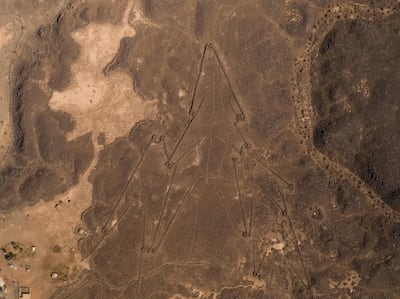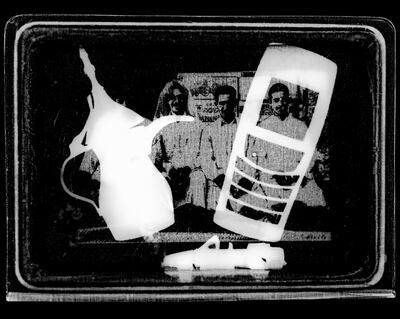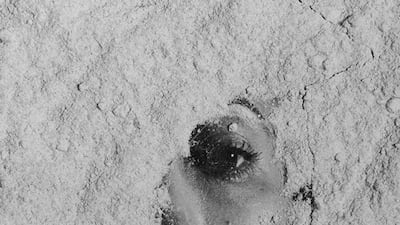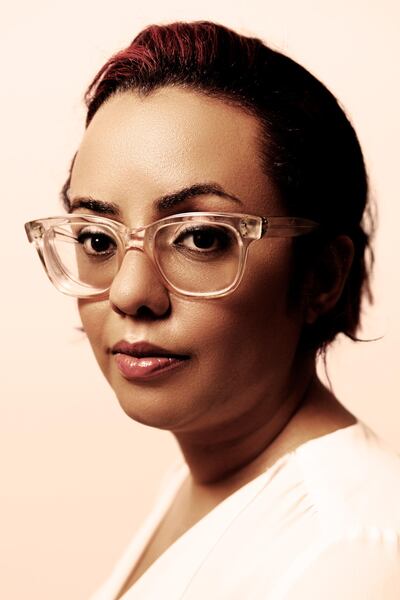“Gulf individuals want to be seen for who they are,” says Bahraini curator Latifa Abdulrahman Al Khalifa. “They don’t want to be categorised under rigid, archaic views of religion, oil or politics; after all, that’s not how one sees people from other parts of the world.”
With her show Imprint: Re-Imagining Identity for the Misk Art Institute in Riyadh, Al Khalifa has collected work in film and video by 17 artists from the Gulf, who address khaleeji identity. The issue has been foremost in cultural work, particularly in Saudi Arabia recently, as artists navigate a shift from the country's restrictive social policies to its embracing of creativity.

The picture they offer is deliberately heterogeneous. Saudi artists use the past to reflect on the present, drawing on different tribal or historical practices to show the country's contemporary diversity. For Thad (2018-2020), Moath Alofi shot drone imagery of geoglyphs – drawings carved into the earth – near his home town of Madinah, which were made 2,000 years ago by the Thamud tribe. The geometric forms and, in an accompanying video, sandstone-coloured dwellings show evidence of ancient civilisations whose stories were left out of official Saudi history until recently.
In Al Fulle (2019), Reem Al Nasser documents the jasmine flowers that brides weave into their hair in the southern province of Asir, capturing the women in the midst of a traditional dance in blurred, low-exposure photographs. The obfuscation of the women's faces here is key, and many artists use technologies to quietly signal what is allowed and not allowed to be seen – and how this too is changing. Maha Malluh's photo series Tradition and Modernity (2008) juxtaposes different items from her house, putting her mobile phone on a par with a dalla, or traditional coffee pot, as emblematic of Saudi life. In its subject matter, it acknowledges the development of Saudi Arabia, while its technique evokes an atmosphere of surveillance, with the photogrammed items pictured as if they are in an X-ray machine at an airport.

Like Malluh's exploration of everyday Saudi life, vernacular practices are also foregrounded elsewhere. Looking to the wisdom of the many, Ajlan Gharem's sprawling, multi-photo installation Mount of Mercy (2012) shows images of the votive goods left on Mount Ararat by pilgrims during Hajj.
If some of the images look outward to emblems of Gulf life, others look inward, in an introspective, emotive tone. A beautiful, if slightly retro series of surrealistic self-portraits by the Kuwaiti artist Maha Alasaker – Self Still Life, (2019) – plays with the symbolism of gestures, foods and fragmentation, as she obscures and reveals her face behind lace veils, collages and scattered sand.
The Key is to Meat in the Middle (2017) by Bahraini artist Mai Almoataz, shows a series of outstretched hands, dangling across three frames in a gesture of openness that carries shades of violence."Someone is trying to connect with people and is not able to. There still exists a stigma against mental health around the world. Mai suggests that you have to compromise, break yourself down even, to connect with others," says Al Khalifa.
Imprint is on show at the Prince Faisal bin Fahd Fine Arts Hall, an exhibition space dating back to 1985, which Misk recently refurbished and reopened to the Riyadh art scene. Because of the coronavirus pandemic, the exhibition is also in digital form, in a 3D viewing room on Misk's website that has been visited 100,000 times since it launched on October 4.
In Bahrain, Al Khalifa operates Too Far, a curatorial agency that promotes Gulf artwork, and runs educational programmes to support emerging Arab artists. This is the first exhibition she has curated in Saudi, though she has collaborated with the country's art community before. In 2013, in London, she curated In the Open, an exhibition on Bahraini art for the Saudi organisation Edge of Arabia. In many ways Imprint has come full circle from her first engagement with Gulf art, which the curator speaks about in terms of identity and recognition. Recalling her experience visiting Edge of Arabia's well-known show of Arab artists, #ComeTogether at the Truman Brewery in East London in 2012, she says: "It was a first for me to see myself and my culture up there on the walls. It felt incredible because it is a form of recognition, an acknowledgement and an appreciation of existence."
Imprint is on show at the Prince Faisal bin Fahd Fine Arts Hall in Riyadh until January 28 and online at www.miskartinstitute.org




